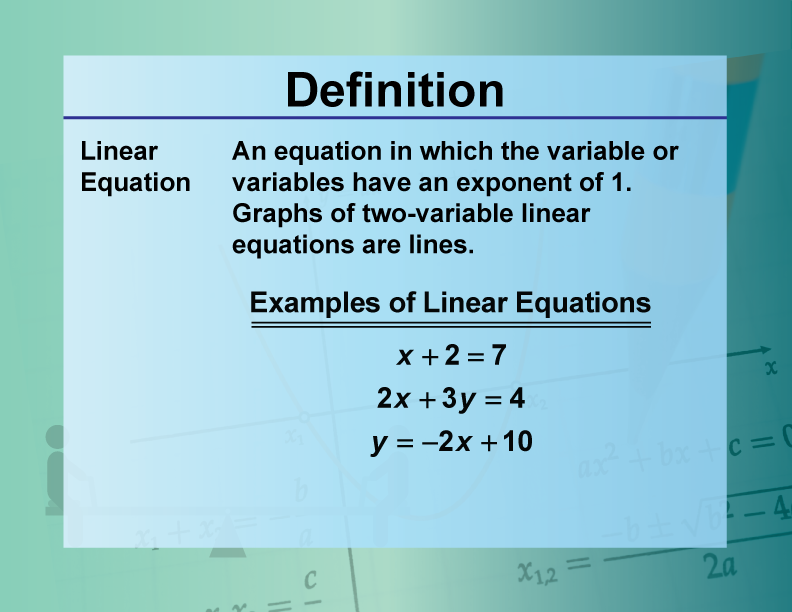
Display Title
Definition--Equation Concepts--Linear Equation
Display Title
Linear Equation

Topic
Equations
Definition
A linear equation is an equation that does not have an variables raised to a power higher than one. A linear equation can have one or more variables.
Description
Linear equations are fundamental in algebra and describe relationships are summarized below.
| ax + b = 0 | Result is a single point on a number line |
| ax + by = c | Result can be an infinite number of (x, y) coordinates that form a straight line |
In real-world applications, linear equations are used to model relationships in economics, physics, and engineering. Understanding linear equations helps students analyze data, make predictions, and solve practical problems.
For a complete collection of terms related to functions and relations click on this link: Functions and Relations Collection
The following section provides additional information on solving one- and two-step equations.
Solving One-Step Equations
A one-step equation can literally be solved in one step. This is because the equation is written in a form such that an inverse operation is enough to solve it. Here are the different forms a one-step equation can take:
| Equation Type | Inverse Operation | Example |
| Addition | Subtraction | |
| Subtraction | Addition | |
| Multiplication | Division | |
| Division | Multiplication |
With these four basic cases, there are a number of variations, depending on the numbers involved. The simplest types of these equations involve positive whole numbers. But these equations can involve integers and rational numbers.
The general form of each of the four types of basic one-step equations are summarized here.
Solving Two-Step Equations
You saw that with one-step equations, the “one step” involved one inverse operation. With two-step equations, there are two inverse operations involved in solving the equation. But this extra step introduces many more types of equations to solve, beyond the basic four from one-step equations.
There are 16 basic types of two-step equations that involve different combinations of the four basic operations.
| Addition | Subtraction | Multiplication | Division | |
| Addition | AA | AS | AM | AD |
| Subtraction | SA | SS | SM | SD |
| Multiplication | MA | MS | MM | MD |
| Division | DA | DS | DM | DD |
These 16 basic examples are summarized in the table below, where we show an example of such an equation using numbers, then followed by a general form of the equation using variables and constant terms.
| Equation Type | Inverse Operations | Example | General Form |
| Addition and Addition | Subtraction and Subtraction | ||
| Addition and Subtraction | Subtraction and Addition | ||
| Addition and Multiplication | Subtraction and Division | ||
| Addition and Division | Subtraction and Multiplication | ||
| Subtraction and Addition | Addition and Subtraction | ||
| Subtraction and Subtraction | Addition and Addition | ||
| Subtraction and Multiplication | Addition and Division | ||
| Subtraction and Division | Addition and Multiplication | ||
| Multiplication and Addition | Division and Subtraction | ||
| Multiplication and Subtraction | Division and Addition | ||
| Multiplication and Multiplication | Division and Division | ||
| Multiplication and Division | Division and Multiplication | ||
| Division and Addition | Multiplication and Subtraction | ||
| Division and Subtraction | Multiplication and Addition | ||
| Division and Multiplication | Multiplication and Division | ||
| Division and Division | Multiplication and Multiplication |
These 16 basic two-step equations come in different forms depending on the sign of the numbers and whether the numbers are integers or rational numbers. The simplest types of these equations involve positive whole numbers.
| Equation Type | General Form |
| Addition | |
| Subtraction | |
| Multiplication | |
| Division |
| Common Core Standards | CCSS.MATH.CONTENT.6.EE.B.5, CCSS.MATH.CONTENT.7.EE.B.4, CCSS.MATH.CONTENT.HSA.REI.A.1 |
|---|---|
| Grade Range | 6 - 12 |
| Curriculum Nodes |
Algebra • Linear Functions and Equations • Applications of Linear Functions |
| Copyright Year | 2021 |
| Keywords | equations, solving equations, definitions, glossary terms |